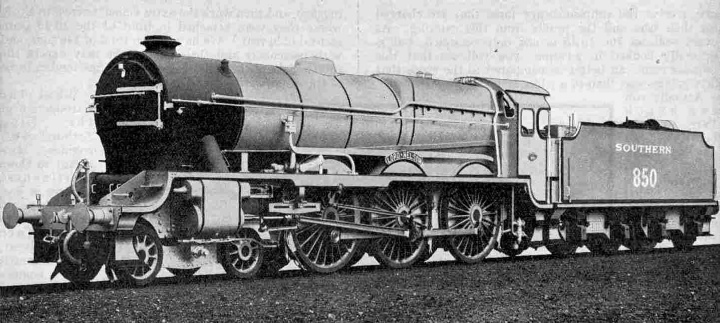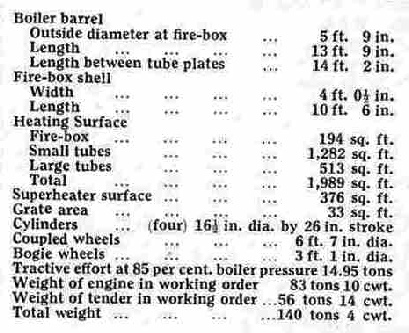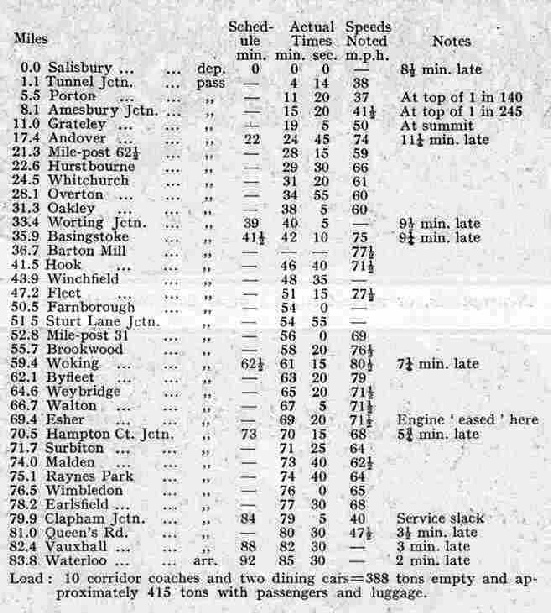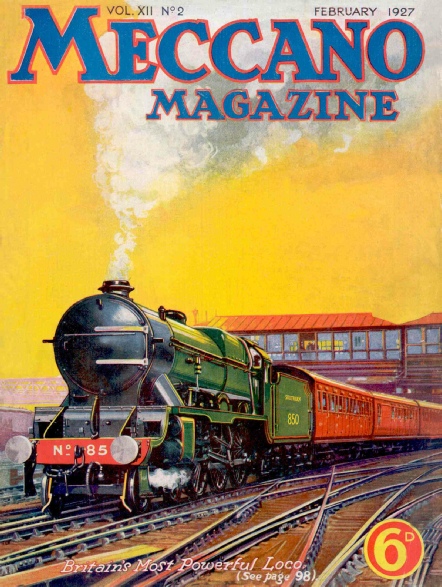
© Railway Wonders of the World 2012-


Britain’s Most Powerful Loco
For Express Passenger Traffic: The “Lord Nelson”

Southern Railway 4-
IN order to cope with the steadily increasing weight of express passenger traffic on the Southern Railway, a new loco-
The “Lord Nelson” has been built to haul trains of 500 tons at an average speed of 55 miles per hour, but since the heaviest passenger trains on the Southern Railway at present rarely exceed 450 tons, the locomotive will possess considerable reserve power.
Most of our readers will be aware that some, two years ago Mr. Maunsell conducted a number of experiments with one of the Drummond four-
The increase in power secured by this alteration was so remarkable that a similar order of cranks which, for reference purposes, can be termed the 135° arrangement, has been embodied in the “Lord Nelson”. In this case, while the crank pins on each of the two driving axles are placed at 90°, one pair is arranged 135° in advance of the second pair. Thus are the eight equally-
 Walschaerts’ valve gear is employed for both inside and outside cylinders and the revolving and reciprocating parts have been made extremely light by the use of a special high-
Walschaerts’ valve gear is employed for both inside and outside cylinders and the revolving and reciprocating parts have been made extremely light by the use of a special high-
The fire-
The cab follows generally the design of Mr. Maunsell’s latest 4-
The double bogie tender is similar to that used with the “King Arthur” engines with the exception that it has straight flat sides with no overhanging coping. It has a capacity for 5,000 gallons of water and five tons of coal. The three steel cylinders that are just discernible in the illustrations at the rear of the tender are auxiliary reservoirs used in connection with the automatic vacuum brake and are specially connected to act on the tender wheels.
The overall dimensions of, the “Lord Nelson” permit of its being worked on any main line section of the Southern Railway, and the leading particulars are as shown in the accompanying table.
When it is recalled that the complete weight of the “King Arthur” class engine with tender is only 34 cwt less than that of the “Lord Nelson”, it will be seen that the considerable increase in power has been achieved only by close attention to detail. The tractive effort, 33,500 lb (14.96 tons), is calculated on the usual basis of 85 per cent, of the boiler pressure and is greater than that of either the GW “Castle” engines or the LNER Pacifics, the tractive efforts of which are 14.12 and 13.32 tons respectively. The “King Arthurs’’ on the Southern Railway have a tractive effort of 11.31 tons.
The “Lord Nelson” has already worked the Waterloo-
The first official run of the “Lord Nelson” took place on 12th October last when the down “Atlantic Coast Express”, 11 a.m. out of Waterloo, was hauled as far as Salisbury, the engine making the return trip from Salisbury on the “up” “Atlantic Coast Express”. The approximate weight of the train in each case was 420 tons.

Side view of the new Southern Railway Locomotive No. 850, “Lord Nelson”.
Leaving Waterloo punctually at 11 a.m, the train consisted of twelve well-
 The return journey provided a greater test of the engine’s capabilities, however, for the start was made 8½ minutes after time and the run throughout was accompanied by a very steady drizzle of rain. Despite this, the train arrived at Waterloo only 2 mins. behind time, having covered the run in 85 mins. 30 secs. From Worting Junction to Esher, 36 miles, the average speed was 73.85 m.p.h, the speed falling below 70 m.p.h. only momentarily to 69 m.p.h. when passing the mile post 31 miles out from Waterloo; while from Grately to Earlsfield, 67 miles, the speed only once dropped below 60 m.p.h.
The return journey provided a greater test of the engine’s capabilities, however, for the start was made 8½ minutes after time and the run throughout was accompanied by a very steady drizzle of rain. Despite this, the train arrived at Waterloo only 2 mins. behind time, having covered the run in 85 mins. 30 secs. From Worting Junction to Esher, 36 miles, the average speed was 73.85 m.p.h, the speed falling below 70 m.p.h. only momentarily to 69 m.p.h. when passing the mile post 31 miles out from Waterloo; while from Grately to Earlsfield, 67 miles, the speed only once dropped below 60 m.p.h.
The details of this run are recorded in the table shown on this page.
The public interest in this great locomotive has been intense and at Waterloo it has been literally besieged by railway enthusiasts. Additional interest also is lent by the fact that the “Lord Nelson” is one of the few locomotives to have been driven by Royalty. The Duke and Duchess of York recently paid a visit to Ashford to fulfil certain engagements, including an inspection of the Southern Railway’s works. After visiting the various erection shops, the Duke and Duchess concluded their tour by mounting the footplate of the “Lord Nelson”, the Duke taking charge of the regulator and driving the engine from the works into Ashford station.
Other engines of the “Nelson” Class are to be built and will be names after the following famous sailors:-
It is not intended to supersede the “King Arthur” Class and in fact further engines of this well-

You can read more on “British Express Locomotives”, “The Golden Arrow” and “The Story of the Southern”, on this website.